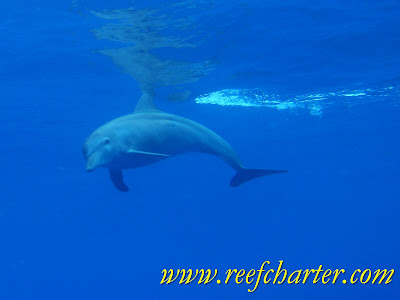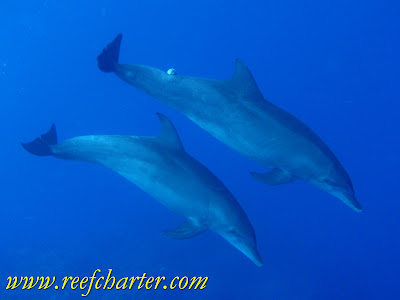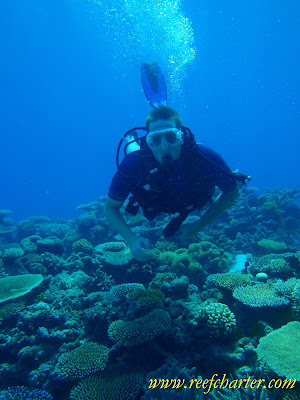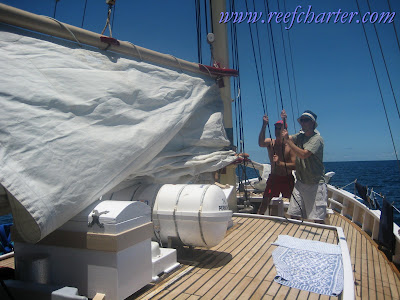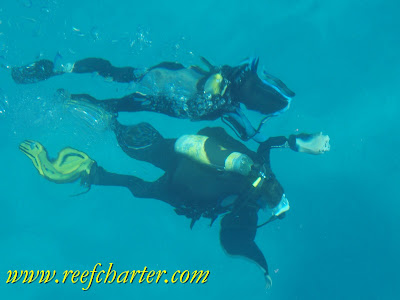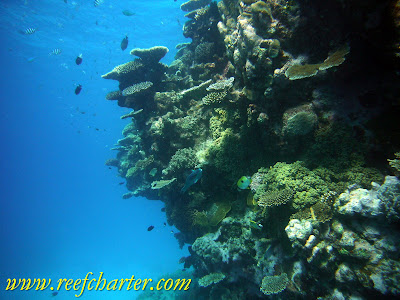Mother nature often gives us some amazing experiences, here two dolphins decided they would like to come and do some diving with us. These two friendly dolphins followed and interacted with our divers and snorkelers for quite a long time. Enjoying the interaction and playing along side our guests and tagging along with our divers. An encounter with a dolphin like this is a fantastic experience and will leave memories that last a lifetime.
Remember, we do not feed or do other activities to attract marine life, so this interaction is completely natural. Making the encounter even more special and truly appreciated. The Great Barrier Reef truly is a natural wonder of diverse and wonderful experiences to be had everyday. If you haven’t been yet you owe it to yourself and family come and experience it. It truly is one of the great wonders of the world and has to be seen to be believed. Yes I love this place! :)
For more photos check out our Tour Photos page or to come and experience the fantastic Great Barrier Reef have a look at our website.
Category: Scuba Diving
10 Tips for Seeing the Most While You Scuba Dive
Seeing many scuba divers from all around the world we get to educate our guests on the best way to experience the wonders of the Great Barrier Reef. So to help everyone out wherever you are we put together these tips to help you see more and experience a more interactive diving experience. The best way to see any dive site is with a guide who knows the area and the native wildlife or coral formations in the area. Don’t be afraid to ask them about the site or tell them what you are interested in.
1. Relax and take things slowly when you dive. Remember you are a stranger with lots of bubbles in the underwater world, so by relaxing and not appearing as a threat you will get more fish remaining for you to enjoy.
2. You are in the homes of the fish, turtles and other marine life that you are looking at. Respect that as you would a friends house. Do not disturb the natural surroundings, avoid kicking up sand and definitely not the coral. So practice your buoyancy away from the reef. Give the fish and reef some distance between you and them about 3ft or 1metre.
3. Do not poke, prod or harass the fish. This can be dangerous to their health and sometimes yours. They will also swim away and maybe relocate so other divers will not get to see them later.
4. Always allow the marine life a clear exit path. Make sure you and your dive buddy or group stay to one side and do not surround the animal you are looking at. If the fish or turtle doesn’t feel threatened it will remain for longer and allow you a better experience.
5. Do not feed the fish, apart from it being bad for the natural ecosystem, you do not get to see the natural behaviour of fish if they are being attracted to divers for the food.
6. Move along slowly in the water and pay close attention to the seascape around you. This helps your navigation but more importantly gives you time to really pay attention to the smaller creatures such as beautiful nudibranchs. Initially frightened fish may pop back out or come back to take a closer look at you.
7. Get into routines for checking your gauges. The best equipment designers in the world not make gauge better looking then the reef that surrounds you, so spending time fiddling with your gauges unnecessarily is time wasted. You can play with your dive computer on the boat as much as you want.
8. Spend some time before you get in the water and on the surface to double check you are comfortable with your equipment. Spending time “playing” with your dive gear underwater distracts you form the dive and also makes you consume air more rapidly.
9. Don’t be afraid to stop in a spot to look more closely and examine the coral formations for starfish, crabs and other beauties that make their homes under the coral. Again relax and practice your buoyancy.
10. Stick with your buddy and take the time to point out the cool things you have found. Four eyes are better then two. Agree with your buddy before you dive on some certain types of marine life that you are interested in. By looking at the same type of marine life you both will focus on areas likely to have the creatures.
Most of all have fun, don’t be nervous and we hope to see you diving on the Great Barrier Reef shortly.
Small Fun Groups and Unique Reef Experiences
Sailing the Santa Maria around the Great Barrier Reef is one of the privileges that we get to enjoy everyday.
Experiencing the romance and character of the historic wooden yachts is a rare experience and something our guests cherish for years, many becoming ‘addicted’ and returning many times for their fix. You can’t help as you sit with only a small group of people and share the water with a select few this is how nature was meant to be experienced.
Whether you want to experience snorkelling without the masses on the water or dive and explore the reef on your own terms and schedule, visiting the reef with small groups allows you to get a more personal and relaxed experience on the reef. Time spent with other passengers and our staff get you to enjoy and learn about the reef in a more intimate and one on one setting. It is an amazing difference as you dive, snorkel and relax on the outer Great Barrier Reef enjoying the coral and wildlife in a much more serene setting.
Scuba Dive, Me? No Way!
We hear this everyday as we meet guests on the boat, and they quickly change their mind after seeing the beautiful world below. Well how do I get to experience this? I don’t have the time or never done anything like it before. The easiest and safest way is known as a resort dive, introductory dive or discover dive. This enables you to experience the joys of diving with a short briefing beforehand and then an experienced dive instructor dives with you. On our reef trips we limit the number of introductory divers to two for each instructor. That means they are in direct contact with you during the dive, there to answer any concerns and help you if you have any issues at all. You are limited to a maximum depth of 12 metres (39ft) and a lot of the time you will be shallower.
So what do I need to do to get started? First of all, there is no one forcing you to try to dive so you have to want to do it yourself. Listen to guides, remember to breathe and most of all relax and have a great time! You will be required to fill out a Medical Questionnaire onboard. Certain conditions automatically preclude people from participating in an Introductory Dive, without getting a Dive Medical Exam and getting a “Fit to Dive” Certificate from an Australian doctor (or one who conforms to the Australian Standard AS4005.1 Compliance). One common condition, among others, is asthma. Click here for more information and/or please ask us if you have any questions or concerns.
Almost without exception as the new diver surfaces they let out expressions of joy. Countless testimonies from our guests count it as one of the best things they have ever done. With a little bit of faith and willingness to have a try you’ll be soon floating around coral walls like the one below. You won’t get a certificate to dive after doing an introductory but more then likely will catch the bug and be wanting to do it again and again. The best part after trying to dive with us you can proudly tell everyone for the rest of your life, “I scuba dived on the Great Barrier Reef.”
